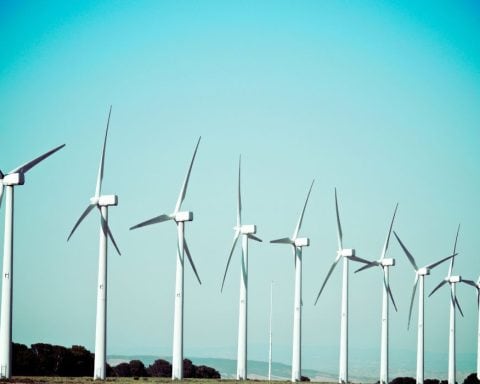On a sleepy swath of farmland near the Six Nations of the Grand River reserve in southwestern Ontario’s Haldimand County, work crews later this year will begin planting a very different type of cash crop in a region of the province that’s well known for its berries, greens and grains. This piece of land is set to become one of North America’s largest battery farms – a facility that will house banks of high-capacity lithium-ion modules capable of storing 1,000 megawatt-hours of electricity, enough to provide four hours of power to 250,000 homes.
This utility-scale project, several years in the making, will provide backup storage to Canada’s most populous province and is being built by Six Nations of the Grand River Development Corporation (SNGRDC) and NRStor, a storage start-up, with $50 million in backing from the Canada Infrastructure Bank. (Tesla, Northland Power and Aecon are also partners.) SNGRDC CEO Matt Jamieson (of the Tuscarora Nation) rhymes off the benefits: local jobs, cleantech investment, emission reductions and a major boost for the region’s clean energy infrastructure, in which Six Nations is a significant investor. Indeed, the deployment of grid-scale energy storage projects will allow wind and solar farms to operate at full capacity – something that hasn’t happened in recent years because Ontario’s system operator curtailed the use of renewables in favour of gas plants that can be turned on and off as demand requires.
But for Jamieson, the Oneida Energy Storage facility’s most salient calling card is that it will kick-start a long overdue investment in a critical piece of the energy transition puzzle that has been overlooked for years. “We are the first movers,” he says of the Indigenous-led project. “We’ve created the utility-scale energy storage market in Ontario.”
The energy transition over the next three decades will be possible only with the deployment of huge electricity storage systems, such as Oneida’s that can hold a charge for up to four hours, as well as other longer-duration storage technologies that can hold energy for 10 hours or longer. The International Energy Agency (IEA) has stated that the rapid scaling up of energy storage systems will be critical to bridge the hour‐to‐hour variability of wind and solar electricity on the grid, “especially as their share of generation increases rapidly in the net zero scenario.” As a 2022 MIT Energy Initiative study put it, “Energy storage enables cost-effective deep decarbonization of electric power systems that rely heavily on wind and solar generation without sacrificing system reliability.”
That goal will require electrical utilities to add tens of thousands of megawatts (MW) of energy storage in large-scale facilities as they expand their portfolio of renewables. Over the past few years, according to IEA data, the U.S., China and Europe have driven up investment in short- and long-term energy storage, with about 6,500 MW installed as of 2021. In the U.S., the world leader, much of that investment has been driven by incentives and building code requirements adopted in states like California and Maryland, with others, like New York, establishing ambitious targets for the next decade.
Ontario is making an especially big bet on storage to help meet the rising electricity demands of electric vehicles and economic growth during the closure of the Pickering nuclear power station. Last year, the province issued a major request for proposals to acquire 2,500 MW in energy storage through 2027; the Oneida project is part of this push – the largest to date in Canada.
Where the sun doesn’t shine
For many years, electricity storage was limited to one technology: pumped hydro. This old-school technique, which requires a lot of civil engineering and dams that have excess generating capacity, uses surplus or inexpensive electricity to run huge pumps that fill hydro reservoirs. The stored energy can be used later when grid operators decide to release the water, thus driving the turbines that generate new power. However, the rapid investment in wind and solar over the past 15 years has raised the stakes for energy storage technologies. Both of these renewables are intermittent, and so it makes sense for utilities or system operators that want to invest in clean generation to figure out how they can store electricity when the sun is shining or the wind is blowing, and then use those stored electrons later, as needed. “There’s a symbiotic relationship between the two,” says Travis Lusney, director of power systems for Power Advisory LLC, a consulting group.
Storage has another potential climate benefit as well. On very hot afternoons when all the air-conditioning is running flat out, or during other times when electricity demand is particularly high, system operators often rely on natural-gas-fired “peaker plants” to provide top-ups. These facilities can be turned on and off quickly (unlike nuclear plants). If power generated by renewables can be stored and then used when demand surges, the storage technology effectively displaces the burning of fossil fuels, thus reducing emissions.
We are the first movers. We’ve created the utility-scale energy storage market in Ontario.
- Matt Jamieson, CEO, Six Nations of the Grand River Development Corporation
Over the past decade or so, a number of energy storage technologies have been piloted, with varying degrees of success. Early wind entrepreneurs thought to run the current generated by a turbine through water, thereby producing hydrogen that can be compressed, stored and used as a fuel. Other approaches include the capture of waste heat or using surplus power in air compressors, with the highly pressurized gas stored and available for later use as an energy source. Justin Rangooni, executive director of Energy Storage Canada, says there are several other short- and long-duration storage technologies in the research-and-development pipeline, many of which rely on various advanced materials, common metals, and chemicals, from sodium to zinc and aluminum.
As the technology and the market mature over the next few years, the choice of the mode of energy storage used by utilities or institutions like hospitals will be determined by the application. “What storage is saying is ‘What do you need [and] what are you trying to achieve?’ and then looking at the menu of options in terms of energy storage technology,” says Rangooni.
Growing battery farms
Battery farms, using large-scale versions of an EV power pack, turn out to be the most scalable solutions for grid operators, and also the most mature from a commercialization perspective. Six Nations’ Jamieson says that during the Oneida planning process, he went to San Francisco to see the plant where Tesla makes the Megapack, and his team also vetted other vendors. “There’s a lot of considerations around emergency-response planning, fire suppression, exposure, protection, earthquake, floods, and all sorts of mitigation tactics have gone into this technology,” he says. “It comes down to the bankability of performance that we’re looking for, to ensure that all stakeholders are satisfied.” Tesla has installed hundreds of megawatts of battery storage capacity in Australia as part of the country’s push to enable utilities to use more renewables without destabilizing grids.
Six Nations had another crucial perspective that informed its decision to pursue the battery farm deal. For several years, the First Nation has invested heavily in solar and wind farms in southwestern Ontario, including on the site of a huge and now decommissioned coal-fired generating plant. But Jamieson says the income from the renewables has ebbed because of a policy called “curtailment,” which means these facilities may be temporarily taken off-grid because the power they’re producing isn’t needed at that moment. “There’s a deferral of compensation, which doesn’t help the ratepayers,” says Jamieson.
Six Nations certainly isn’t the only renewables producer that has faced this problem, which occurs specifically because this clean power can’t be stored until it’s needed. Investments in large-scale battery storage will effectively have a double benefit because they’ll enable those wind and solar farms to generate more revenue for the community, Jamieson points out. “We look at this from [the perspective of] where’s the opportunity to enhance the positioning of renewables in the province? Without some sort of an energy storage solution, we will be continually facing this [issue because] of the intermittent nature of how renewables function.”
The sprawling new Oneida battery farm, as he puts it, “is a new tool in the tool kit.”
Toronto journalist John Lorinc writes about cities, sustainability, and business.





